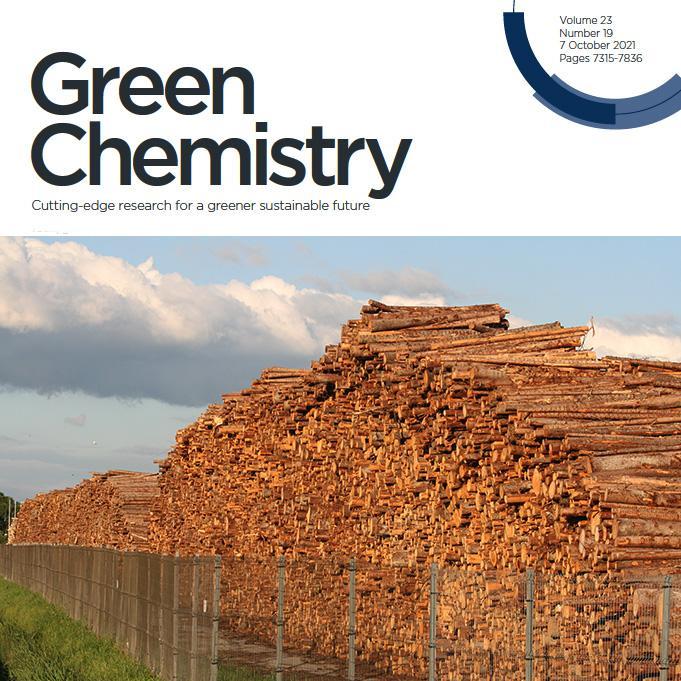Producing Active Pharmaceutical Ingredients from Lignin using Green Chemistry
Jan 11, 2022 — Atlanta, GA

Green Chemistry Journal (Header). Pictured: wood pulp is a major source for lignin.
Lignin, which is second to cellulose as the most abundant organic material on Earth, could be a source for the production of active pharmaceutical ingredients (APIs) using Green Chemistry production processes that reduce waste. APIs are the central part of any drug that produce the intended beneficial effect. (Other parts of the drug, called the excipient, aid in the delivery of the API medication to the targeted area of the human body).
Lignin, an abundant renewable material, can be converted to phenol and catechol, which can then be further converted into four important APIs: paracetamol (Tylenol®), acetyl salicylic acid (Aspirin®), amoxicillin (as sole API or as combination with potassium clavulanate (Augmentin®), and epinephrine (adrenaline, known also as trademark Adrenaline®).
A perspective paper by a team of Georgia Tech researchers focused on these important ingredients examines API production from renewable materials, in this case Lignin as the renewable material, and how Green Chemistry production could combine a low environmental footprint with high quality and economical manufacture of pharmaceuticals using Lignin.
Their paper, “Production of active pharmaceutical ingredients (APIs) from lignin-derived phenol and catechol,” was published in the October 7, 2021 issue of Green Chemistry.
The research team that wrote the paper include: Andreas Bommarius, professor of Chemical and Biomolecular Engineering at the Georgia Institute of Technology; Carsten Sievers, associate professor in the School of Chemical and Biomolecular Engineering at the Georgia Institute of Technology; Jimin Park, a Ph.D. student in the Georgia Tech School of Chemical and Biomolecular Engineering; Jason Kang, Siddarth Seemakurti, and Jasmine Ramirez, who are each pursuing a Bachelor of Science in the Georgia Tech School of Chemical and Biomolecular Engineering; Marta Hatzell, an associate professor in the Woodruff School of Mechanical Engineering at the Georgia Institute of Technology; and Megan Kelly, a graduate student at the University of Wisconsin. Park, Sievers, and Bommarius are affiliated with Georgia Tech’s Renewable Bioproducts Institute.
APIs are traditionally created by pharmaceutical companies and most of this production has shifted oversees where costs of production are lower than the USA and Europe. (As a result, rigorous guidelines and inspections have been put into place when these API ingredients are imported).
API production often suffers from unfavorable Green Chemistry metrics. Green Chemistry is a new way of thinking about how chemistry and chemical engineering (i.e. processes) are done. Benefits of applying Green Chemistry can include conserving energy, producing less hazardous substances, creating more sustainable processes, producing less waste, producing less pollution, using renewable feedstocks, designing systems holistically using life cycle thinking, etc.
With current supply chain disruptions, there has been renewed interest in reshoring drug production. New initiatives, such as the Food and Drug Administration’s (FDA) Emerging Technology Program, have tried to reduce barriers to advanced manufacturing techniques that can make domestic production more economically attractive. A collaboration between the FDA and the Biomedical Advanced Research and Development Authority (BARDA) is trying to develop mobile manufacturing platforms to produce APIs on demand near point of care. Furthermore, the European Commission has been proposing road maps to reduce dependence on outsourced products and secure Europe's supply chain.
Lignin, the second most prevalent component of plant biomass after cellulose, fills several criteria for a desirable fossil resource substitute through its abundance, renewability, and carbon neutrality. However, it is difficult to convert because it naturally occurs in a heterogeneous composite of cellulose, hemicellulose, and lignin from which it must first be liberated. In addition, lignin itself is complex, irregular, and highly oxygenated, and its purpose of providing rigidity in the plant cell wall contributes to its resistance to biomass conversion.
Despite these difficulties, much progress has been made on overcoming them through a focus on the fractionation of lignocellulose, depolymerization of lignin, and upgrading the resulting monomers into valuable products.
Walter Rich




